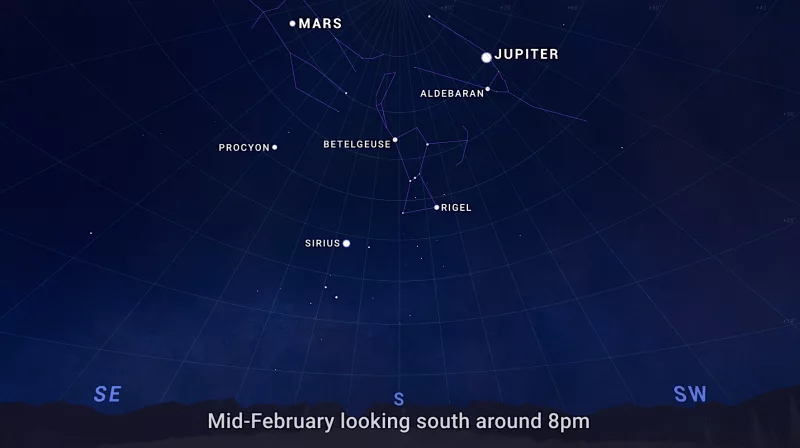
By Elizabeth Barhydt
NASA has given humanity a front-row seat to the cosmos, making the impossible seem within reach. From the Apollo missions to the Mars rovers, NASA’s work is the foundation of our understanding of the universe. Now, the space agency is bringing another celestial spectacle into focus: a planetary dance that will light up the skies in 2025.
February is a month of bright planets and significant lunar events. Venus will shine at its most brilliant after sunset, while Mars and Jupiter dominate the evening sky. Saturn, though dimmer, will be visible in the west for the first hour after sunset before dipping below the horizon.
For those looking to pinpoint specific dates, NASA suggests the following:
February 9: A nearly full Moon will sit just below Mars, with the bright Gemini stars Pollux and Castor nearby. Best seen with the naked eye or binoculars.
February 12: The Lantern Festival, the 15th and final day of Lunar New Year celebrations, marks the first full moon after the Lunar New Year. Cities across the world will celebrate with illuminated displays and lantern processions.
February 12: Full Moon, offering a spectacular view with the naked eye or a telescope to capture detailed lunar features.
The Lunar New Year, which began on January 29, marked the start of the Year of the Wood Snake in the traditional Chinese lunisolar calendar. The date is determined by the second new moon after the winter solstice, ensuring its placement between January 21 and February 20 each year. Followers of the Chinese zodiac believe the year’s fortune is influenced by the Tai Sui, a set of deities thought to rotate opposite Jupiter.
Beyond planetary alignments, Venus itself will be a focal point in early 2025. As it reaches its peak brightness in February, skywatchers will witness its unique phase cycle. Unlike the Moon, Venus is at its brightest not when it is “full,” but when it is a thinner crescent. The reason is distance—Venus appears fuller when it is on the far side of the Sun but is much farther from Earth. When it’s closer to us, its phase becomes a crescent, but its apparent size in the sky increases, making it shine more brilliantly.
Later in the year, Venus and Jupiter will create a breathtaking display on August 12 when they align just one degree apart in the constellation Gemini. These two planets, the brightest in our night sky, will form what appears to be a “double star,” visible to the naked eye. Venus, glowing at a brilliant magnitude of -4, will overshadow Jupiter’s still-impressive magnitude -2. The event coincides with the peak of the Perseid meteor shower, offering skywatchers a rare double feature—a luminous planetary alignment paired with one of the most dazzling meteor showers of the year.
NASA’s predictions for 2025 go beyond this singular event. The coming year w ill feature three triple conjunctions, where the Moon joins two planets in a stunning celestial grouping. The first occurs in the predawn hours of April 25, when a waning crescent Moon will pass close to Venus and Saturn, forming a celestial “smiley face.” For those with telescopes, Neptune will also be visible nearby. Mercury will make an appearance low on the horizon, though it will be challenging to spot.
The final triple conjunction of the year comes on September 19, featuring the Moon, Venus, and Regulus— the brightest star in Leo. In the eastern predawn hours, a thin, waning crescent Moon will move close to Venus and Regulus, creating an arrangement best seen through binoculars for sharp detail. Around this time, Venus and Regulus will already be in conjunction, with the Moon completing the trio for an unforgettable display.
For those keeping an eye on the night sky, 2025 will be a year to remember. Whether it’s the cosmic pairing of Venus and Jupiter, the rare triple conjunctions, or the steady presence of bright planets throughout the year, NASA has given us a detailed roadmap to celestial wonders. No special equipment is needed—just a clear sky and the curiosity to look up.
For those wanting to bring a piece of the cosmos indoors, NASA recommends tools like Mova Globes, which offer a rotating view of Earth, the Moon, and beyond. But nothing compares to witnessing the real thing. Keep your eyes to the sky, because the universe is putting on a show




